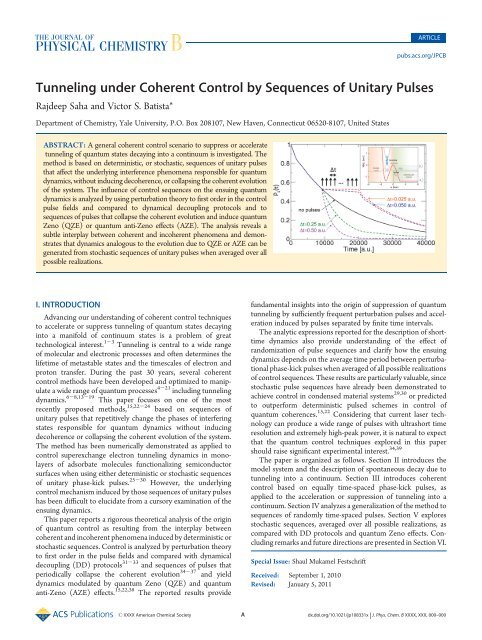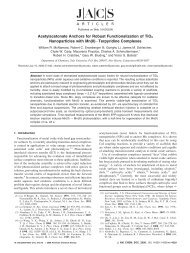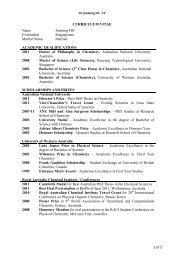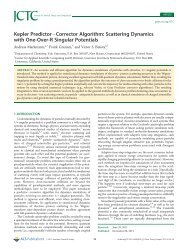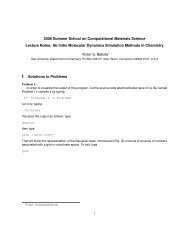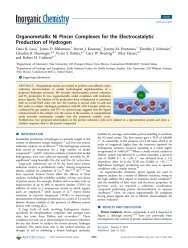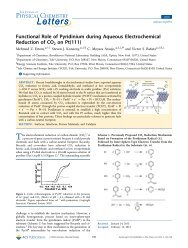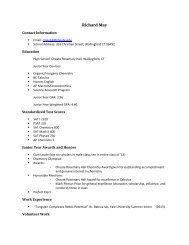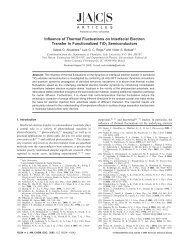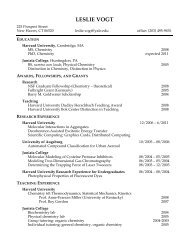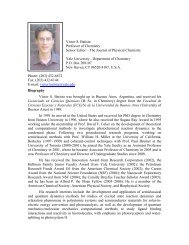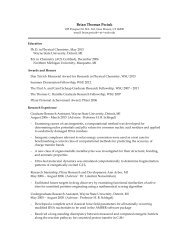J. Phys. Chem. B 115, 5234-5242. - Yale Chemistry - Yale University
J. Phys. Chem. B 115, 5234-5242. - Yale Chemistry - Yale University
J. Phys. Chem. B 115, 5234-5242. - Yale Chemistry - Yale University
You also want an ePaper? Increase the reach of your titles
YUMPU automatically turns print PDFs into web optimized ePapers that Google loves.
ARTICLE<br />
pubs.acs.org/JPCB<br />
Tunneling under Coherent Control by Sequences of Unitary Pulses<br />
Rajdeep Saha and Victor S. Batista*<br />
Department of <strong>Chem</strong>istry, <strong>Yale</strong> <strong>University</strong>, P.O. Box 208107, New Haven, Connecticut 06520-8107, United States<br />
ABSTRACT: A general coherent control scenario to suppress or accelerate<br />
tunneling of quantum states decaying into a continuum is investigated. The<br />
method is based on deterministic, or stochastic, sequences of unitary pulses<br />
that affect the underlying interference phenomena responsible for quantum<br />
dynamics, without inducing decoherence, or collapsing the coherent evolution<br />
of the system. The influence of control sequences on the ensuing quantum<br />
dynamics is analyzed by using perturbation theory to first order in the control<br />
pulse fields and compared to dynamical decoupling protocols and to<br />
sequences of pulses that collapse the coherent evolution and induce quantum<br />
Zeno (QZE) or quantum anti-Zeno effects (AZE). The analysis reveals a<br />
subtle interplay between coherent and incoherent phenomena and demonstrates<br />
that dynamics analogous to the evolution due to QZE or AZE can be<br />
generated from stochastic sequences of unitary pulses when averaged over all<br />
possible realizations.<br />
I. INTRODUCTION<br />
Advancing our understanding of coherent control techniques<br />
to accelerate or suppress tunneling of quantum states decaying<br />
into a manifold of continuum states is a problem of great<br />
technological interest. 1-3 Tunneling is central to a wide range<br />
of molecular and electronic processes and often determines the<br />
lifetime of metastable states and the timescales of electron and<br />
proton transfer. During the past 30 years, several coherent<br />
control methods have been developed and optimized to manipulate<br />
a wide range of quantum processes 4-21 including tunneling<br />
dynamics. 6-8,13-19 This paper focuses on one of the most<br />
recently proposed methods, 15,22-24 based on sequences of<br />
unitary pulses that repetitively change the phases of interfering<br />
states responsible for quantum dynamics without inducing<br />
decoherence or collapsing the coherent evolution of the system.<br />
The method has been numerically demonstrated as applied to<br />
control superexchange electron tunneling dynamics in monolayers<br />
of adsorbate molecules functionalizing semiconductor<br />
surfaces when using either deterministic or stochastic sequences<br />
of unitary phase-kick pulses. 25-30 However, the underlying<br />
control mechanism induced by those sequences of unitary pulses<br />
has been difficult to elucidate from a cursory examination of the<br />
ensuing dynamics.<br />
This paper reports a rigorous theoretical analysis of the origin<br />
of quantum control as resulting from the interplay between<br />
coherent and incoherent phenomena induced by deterministic or<br />
stochastic sequences. Control is analyzed by perturbation theory<br />
to first order in the pulse fields and compared with dynamical<br />
decoupling (DD) protocols 31-33 and sequences of pulses that<br />
periodically collapse the coherent evolution 34-37 and yield<br />
dynamics modulated by quantum Zeno (QZE) and quantum<br />
anti-Zeno (AZE) effects. 15,22,38 The reported results provide<br />
fundamental insights into the origin of suppression of quantum<br />
tunneling by sufficiently frequent perturbation pulses and acceleration<br />
induced by pulses separated by finite time intervals.<br />
The analytic expressions reported for the description of shorttime<br />
dynamics also provide understanding of the effect of<br />
randomization of pulse sequences and clarify how the ensuing<br />
dynamics depends on the average time period between perturbational<br />
phase-kick pulses when averaged of all possible realizations<br />
of control sequences. These results are particularly valuable, since<br />
stochastic pulse sequences have already been demonstrated to<br />
achieve control in condensed material systems 29,30 or predicted<br />
to outperform deterministic pulsed schemes in control of<br />
quantum coherences. 15,22 Considering that current laser technology<br />
can produce a wide range of pulses with ultrashort time<br />
resolution and extremely high-peak power, it is natural to expect<br />
that the quantum control techniques explored in this paper<br />
should raise significant experimental interest. 34,39<br />
The paper is organized as follows. Section II introduces the<br />
model system and the description of spontaneous decay due to<br />
tunneling into a continuum. Section III introduces coherent<br />
control based on equally time-spaced phase-kick pulses, as<br />
applied to the acceleration or suppression of tunneling into a<br />
continuum. Section IV analyzes a generalization of the method to<br />
sequences of randomly time-spaced pulses. Section V explores<br />
stochastic sequences, averaged over all possible realizations, as<br />
compared with DD protocols and quantum Zeno effects. Concluding<br />
remarks and future directions are presented in Section VI.<br />
Special Issue: Shaul Mukamel Festschrift<br />
Received: September 1, 2010<br />
Revised: January 5, 2011<br />
r XXXX American <strong>Chem</strong>ical Society A dx.doi.org/10.1021/jp108331x | J. <strong>Phys</strong>. <strong>Chem</strong>. B XXXX, XXX, 000–000
The Journal of <strong>Phys</strong>ical <strong>Chem</strong>istry B<br />
ARTICLE<br />
Figure 1. (a) Unstable quantum state |sæ tunneling into a manifold of continuum states |k 1 æ|k n æ with couplings V ks . The initial metastable state Æx|sæ =<br />
Φ 0 (x) isdefined as the ground state of an electron in the quadratic approximation to the quartic potential V(x) =-Rx 2 þ βx 4 with R = 1/2 and<br />
β = 0.0461. (b) Time-dependent population P s (t)=Æj t |1 - h(x̂)|j t æ due to evolution on V(x), with V(x)=V(x e ) for x < x e = 2.33 au, as modulated by<br />
instantaneous 2π pulses applied at time intervals Δt. Here, h(x) = 1 for x < 0 and h(x) = 0, otherwise. 22 .<br />
II. TUNNELING INTO A CONTINUUM<br />
We consider the system depicted in Figure 1, initially prepared<br />
in a bound metastable state |sæ coupled to a continuum, as<br />
described by the following Hamiltonian: 39,40<br />
^H ¼ ω s jsæÆsjþ X k<br />
ω k jkæÆkjþ X k<br />
ðV ks jkæÆsjþV sk jsæÆkjÞ<br />
ð1Þ<br />
where |sæ and |kæ are stationary eigenstates of Ĥ, when V ks =0,<br />
with energies ω s and ω k , respectively. For simplicity, notation is<br />
kept in atomic units (with p =1). When V ks 6¼ 0, state |sæ is<br />
nonstationary. Therefore, a system initially prepared in state |sæ<br />
spontaneously decays by tunneling into the continuum. In the<br />
absence of external perturbations, the time-evolution is described<br />
by the time-dependent wave function,<br />
ΨðtÞ ¼R s ðtÞ e -iωst jsæ þ X β k ðtÞ e -iωkt jkæ ð2Þ<br />
k<br />
with R s (0) = 1, and β k (0) = 0 for all |kæ. The equations of motion<br />
of the time-dependent expansion coefficients, introduced by<br />
eq 2, are obtained by solving the time-dependent Schr€odinger<br />
equation, as follows:<br />
_R s ¼ - i X k<br />
V sk e iðω s - ω k Þt β k<br />
_ β k ¼ - iV ks e iðω k - ω s Þt R s<br />
Integrating eq 4 from time t b to time t yields<br />
Z t<br />
ð3Þ<br />
ð4Þ<br />
β k ðtÞ - β k ðt b Þ¼ - i V ks e iðω k - ω s Þt 0 R s ðt 0 Þ dt 0 ð5Þ<br />
t b<br />
and substituting eq 5 into eq 3 gives<br />
_R s ¼ - X k<br />
Z t<br />
t b<br />
jV ks j 2 e iðω k - ω s Þðt 0 - tÞ R s ðt 0 Þ dt 0<br />
- i X V sk e iðω s - ω k Þt β k ðt b Þ<br />
ð6Þ<br />
k<br />
Equation 6 can be solved exactly by using standard Laplace<br />
transform techniques; 34,41 however, for sufficiently short time<br />
intervals, one can approximate R s (t 0 ) ≈ R s (t b ) as shown in<br />
Appendix A and obtain the following solution of eq 6: 41,42<br />
R s ðtÞ R s ðt b Þ 1 - X Z !<br />
t<br />
jV ks j 2 ðt - t 0 Þe iΩ ksðt 0 - t b Þ dt 0<br />
k t b<br />
- i X Z t<br />
V sk e iΩ skt 0 β k ðt b Þ dt 0 ð7Þ<br />
k t b<br />
where we introduced Ω sk = ω s - ω k . Similarly, the expansion<br />
coefficients for states |kæ are obtained from eq 5, as follows:<br />
Z t<br />
β k ðtÞ β k ðt b Þ - iR s ðt b Þ V ks e iΩ skt 0 dt 0<br />
It is important to note that the above approximation holds only in<br />
the limit of short time intervals for which t - t b
The Journal of <strong>Phys</strong>ical <strong>Chem</strong>istry B<br />
Repeating steps 1-4 n times, evolves the system to time t =<br />
2nΔt, yielding the expansion coefficients R s (2nΔt) and β k (2nΔt)<br />
for states |sæ and |kæ, respectively.<br />
For simplicity, we consider the specific case of sequences of 2π<br />
pulses, for which each pulse, Q̂, changes the sign of the projection of<br />
the time-evolved wave function along the direction of |sæ as follows:<br />
^Q jψæ ¼jψæ - 2jsæÆsjψæ ¼ X jkæÆkjψæ - jsæÆsjψæ ð10Þ<br />
k<br />
leaving unaffected the projection of |ψæ along the manifold of states<br />
|kæ in the continuum. Therefore, 2π pulses can be represented as<br />
Q s =1- |sæÆs|, yielding the following evolution for the expansion<br />
coefficients:<br />
!<br />
e iΩksΔt - 1<br />
β k ðΔtÞ ¼ β k ð0Þ - iV ks R s ð0Þ<br />
iΩ ks<br />
<br />
R s ðΔtÞ ¼ R s ð0Þ 1 - R <br />
Δt<br />
ðΔt - t 0 Þ Kðt 0 Þ dt 0<br />
- i X k<br />
0<br />
Z Δt<br />
V sk e iΩskt β k ð0Þ dtR 0 s ðΔtÞ ¼-R sðΔtÞ<br />
β k ð2ΔtÞ ¼β k ðΔtÞ - iV ks<br />
R 0 s ð2ΔtÞ ¼R0 s ðΔtÞ<br />
0<br />
!<br />
e i2ΩkSΔt - e iΩ ksΔt<br />
R 0 s<br />
iΩ ðΔtÞ<br />
ks<br />
Z !<br />
2Δt<br />
1 - ð2Δt - t 0 Þ Kðt 0 - ΔtÞ dt 0<br />
Δt<br />
- i X Z 2Δt<br />
V sk e iΩskt β k ðΔtÞ dt<br />
k Δt<br />
R s ð2ΔtÞ ¼-R 0 s ð2ΔtÞ<br />
ð11Þ<br />
where K(t)= P k|V ks | 2 e iΩ skt . Collecting the expressions, introduced<br />
by eq 11, with R s (0) = 1 and β k (0) = 0, we obtain<br />
ARTICLE<br />
and changing the limits of integration in eq 13, we obtain<br />
Terms from I ¼ 2nΔt X Z Δt<br />
<br />
jV ks j 2 1 - t0<br />
e iΩ skt 0 dt 0 ð14Þ<br />
k 0 Δt<br />
Similarly, contributions from terms II and III are obtained, as follows:<br />
TermsfromIIandIII ¼ X k<br />
2n X- 1<br />
j ¼ 1<br />
Z fj þ 1gΔt<br />
ð-1Þ j V sk e iΩskt0 β k ðjΔtÞ dt 0<br />
ð15Þ<br />
where the summation over j starts at j = 1 because β k (0) = 0.<br />
Substituting 14 and 15 into 12, we obtain<br />
R s ð2nΔtÞ ¼ 1 - 2nΔt R <br />
Δt<br />
0 1 - t0<br />
Kðt 0 Þ dt 0<br />
- i X k<br />
2n X- 1<br />
j ¼ 1<br />
jΔt<br />
Δt<br />
Z fj þ 1gΔt<br />
ð-1Þ j V sk e iΩ skt 0 β k ðjΔtÞ dt 0<br />
jΔt<br />
Z Δt<br />
<br />
1 - t0<br />
0 Δt<br />
ð-1Þ j e iΩ skt 0 - 1<br />
V sk<br />
¼ 1 - 2nΔt<br />
Kðt 0 Þ dt 0<br />
- i X !<br />
2n X- 1<br />
β<br />
iΩ k ðjΔtÞ ð16Þ<br />
k j ¼ 1<br />
sk<br />
Appendix B shows that one can introduce the substitution,<br />
" #<br />
β k ðjΔtÞ ¼ V ks e ΩksΔt - 1<br />
Ω ks e Ω fð - 1Þ j e iΩksjΔt - 1g ð17Þ<br />
ksΔt<br />
þ 1<br />
into eq 16 to obtain<br />
- X k<br />
R s ð2nΔtÞ ¼1 - 2nΔt<br />
e iΩ skΔt jV ksj 2<br />
Ω ks<br />
2<br />
Z Δt<br />
0<br />
ðe iΩ ksΔt - 1Þ 2<br />
e iΩ ksΔt<br />
þ 1<br />
<br />
1 - t0<br />
Kðt 0 Þ dt 0<br />
Δt<br />
X<br />
f1 - ð-1Þ j e iΩskjΔt g<br />
2n - 1<br />
j ¼ 1<br />
ð18Þ<br />
where terms of O(|V ks | 3 ) have been neglected. Terms II and III<br />
have opposite signs and, therefore, introduce the couplings to the<br />
continuum with interference effects.<br />
Repeating the process described above n times, we obtain<br />
R s (2nΔt). The contributions to R s (2nΔt) from term I are<br />
The summation over j in eq 18, as detailed in Appendix D,<br />
leads to the central result of this paper:<br />
Terms from I ¼ P k<br />
jV ks j 2R Δt<br />
ðΔt - t 0 Þe iΩ skt 0 dt 0 þ :::<br />
0<br />
þ X k<br />
jV ks j 2 Z jΔt<br />
ðj - 1ÞΔt<br />
þ X k<br />
ðjΔt - t 0 Þe iΩ skðt 0 - ½j - 1ŠΔtÞ dt 0 þ :::<br />
jV ks j 2 Z<br />
ð2n - 1ÞΔt<br />
2nΔt ð2nΔt - t 0 Þe iΩ skðt 0 - ½2n - 1ŠΔtÞ dt 0<br />
ð13Þ<br />
C dx.doi.org/10.1021/jp108331x |J. <strong>Phys</strong>. <strong>Chem</strong>. B XXXX, XXX, 000–000
The Journal of <strong>Phys</strong>ical <strong>Chem</strong>istry B<br />
Equation 19 is an important result, since it provides an explicit<br />
description of the state amplitude, R s (2nΔt), as a function of the<br />
time interval Δt between phase-kick pulses, yielding fundamental<br />
insight into the origin of interference phenomena introduced by<br />
the various terms. In addition, eq 19 allows for calculations of the<br />
survival probability of state |sæ:<br />
with<br />
A ¼ 2Re P jV ks j 2R <br />
Δt<br />
1 - t0<br />
e iΩ skt 0 dt 0<br />
0<br />
k<br />
Δt<br />
<br />
¼ Δt X sin 2 Ω sk Δt<br />
jV ks j 2 2<br />
<br />
k<br />
Ω sk Δt 2<br />
2<br />
B ¼ 2Re X F 1 k ¼ X jV ks j 2 <br />
<br />
k<br />
k<br />
Ω 2<br />
tan 2 Δt<br />
Ω sk sin 2 2nΔt<br />
Ω sk<br />
sk<br />
2<br />
2<br />
2<br />
C ¼ 2Re X F 2 k ¼ - 2n X Δt<br />
Ω sk<br />
jV ks j 2sin2 <br />
2<br />
k<br />
k<br />
Ω 2<br />
ð21Þ<br />
sk<br />
2<br />
Note that terms A and C in eq 20 cancel each other, and term B<br />
determines the time-dependent survival probability, as follows:<br />
jR s ð2nΔtÞj 2 ¼ 1 - 2Re X F 1 k<br />
k<br />
¼ 1 - X jV ks j 2 <br />
<br />
k<br />
Ω 2<br />
tan 2 Δt<br />
Ω sk sin 2 2nΔt<br />
Ω sk<br />
sk<br />
2<br />
2<br />
2<br />
ð22Þ<br />
Equation 22 gives the survival probability, P s (t)=|R s (t)| 2 ,asa<br />
function of the time interval Δt between pulses. Note that when<br />
the time interval between pulses is large, eq 22 is identical to eq 9<br />
describing the spontaneous decay in the absence of pulses.<br />
However, due to the modulatory factor tan 2 (ω s -ω k )Δt/2 in<br />
eq 22, decay is suppressed when the time interval between pulses<br />
is sufficiently short, Δt f 0 (with t =2nΔt), and accelerated<br />
relative to spontaneous decay when tan 2 (Ω sk Δt/2) = tan 2 ((ω s -<br />
ω k )Δt/2) > 1. Maximum acceleration is achieved when Δt =<br />
π/(ω s -ω k ). Equation 22 agrees with previous work, 23,24 including<br />
the study of decay into a continuum, 27,29,44 and the decay of<br />
coherences in a system of spin 1/2 qubits in contact with a bosonic<br />
bath when periodically pulsed by dynamical decoupling sequences.<br />
29 The derivation presented in this section, however, is novel,<br />
since contrary to earlier studies, it is derived from eq 19, providing<br />
an explicit description of the evolution of the expansion coefficient,<br />
R s (t), as a function of the time interval Δt between pulses.<br />
IV. STOCHASTIC PULSING<br />
ARTICLE<br />
This section analyzes stochastic sequences of 2π pulses, using<br />
the perturbational treatment introduced in Section III. Rather<br />
than pulsing the system deterministically, as in Section III,<br />
stochastic sequences pulse the system at time intervals Δt, but<br />
only with 50% probability.<br />
To obtain the survival probability P s (t) =|R s (t)| 2 at time t =<br />
2nΔt, we analyze first the state of the system at time t =2Δt,<br />
obtained by propagating the expansion coefficients for states |sæ<br />
and |kæ, as follows:<br />
!<br />
e iΩskΔt - 1<br />
β k ðΔtÞ ¼β k ð0Þ - iV ks R s ð0Þ<br />
iΩ sk<br />
R s ðΔtÞ ¼R s ð0Þ 1 -<br />
- i X k<br />
β k ð2ΔtÞ ¼β k ðΔtÞ - iV ks<br />
R 0 s ð2ΔtÞ ¼R0 s ðΔtÞ<br />
- i X k<br />
Z Δt<br />
0<br />
ðΔt - t 0 Þ Kðt 0 Þ dt 0 !<br />
Z Δt<br />
V sk e iΩskt β k ð0Þ dt<br />
0<br />
R 0 s ðΔtÞ ¼ξ 1 R s ðΔtÞ<br />
!<br />
e iΩsk2Δt - e iΩ skΔt<br />
R 0 s<br />
iΩ ðΔtÞ<br />
sk<br />
Z !<br />
2Δt<br />
1 - ð2Δt - t 0 Þ Kðt 0 - ΔtÞ dt 0<br />
Δt<br />
Z 2Δt<br />
V sk e iΩskt β k ðΔtÞ dt<br />
Δt<br />
R 0 s ð2ΔtÞ ¼ξ 2 R 0 s ð2ΔtÞ<br />
ð23Þ<br />
where ξ j are stochastic variables that take on values of (1 with<br />
equal probability and correspond to the system being perturbed<br />
(i.e., ξ j = -1) by a 2π pulse (i.e., Q̂ =1- |sæÆs|) at time t j = jΔt,or<br />
not (i.e., ξ j = 1). 46 The expansion coefficients for the continuum<br />
states are obtained as follows:<br />
! 0<br />
1<br />
e iðω k - ω s ÞΔt - 1<br />
β k ðlΔtÞ ¼ - iV ks<br />
@ 1 þ Xl - 1<br />
iðωk - ωsÞjΔt<br />
ξ<br />
iðω k - ω s Þ<br />
j e A<br />
j ¼ 1<br />
and the time evolution of the initially populated state |sæ is<br />
ð24Þ<br />
Note that in the limit when ξ j = 1 (i.e., pulses with 0%<br />
efficiency), eq 25 yields<br />
jRð2nΔtÞj 2 ¼ 1 - X jV ks j 2 <br />
<br />
k Ω 2<br />
sin 2 2nΔt<br />
Ω sk ð26Þ<br />
sk<br />
2<br />
2<br />
D dx.doi.org/10.1021/jp108331x |J. <strong>Phys</strong>. <strong>Chem</strong>. B XXXX, XXX, 000–000
The Journal of <strong>Phys</strong>ical <strong>Chem</strong>istry B<br />
which is the expression for spontaneous decay, introduced by<br />
eq 9. 34 More generally, the survival probability of the system<br />
evolving under the effect of pulses with ξ j 6¼ 1is<br />
jRð2nΔtÞj 2 ¼jGj 2 - 2ReðFGÞþjFj 2<br />
jGj 2 ¼ 1 - 2Re<br />
FG ¼ Y2n<br />
j ¼ 1<br />
X X<br />
ξ j<br />
k<br />
2nΔt<br />
Z Δt<br />
0<br />
2n - 1 Y 2n<br />
ξ a<br />
l ¼ 1 a ¼ l<br />
!<br />
1 -<br />
Kðt t0 0 Þ dt 0<br />
Δt<br />
!<br />
e -iΩ ks½l þ 1ŠΔt - e -iΩ kslΔt<br />
iΩ sk<br />
!<br />
jV ksj 2<br />
ksΔt<br />
ðΩ ks Þ 2ðeiΩ - 1Þ 1 þ Xl - 1<br />
ξ b e iΩ ksbΔt<br />
b ¼ 1<br />
ð27Þ<br />
where |F| 2 is neglected, since it involves terms of O(|V ks | 4 ).<br />
Equation 27 shows that coherent control can be achieved with<br />
stochastic sequences of phase-kick pulses. Note that the population<br />
decay is suppressed (i.e., |R(2nΔt)| 2 f 1) when Δt f 0. In<br />
addition, decay can be accelerated relative to the spontaneous<br />
behavior described by eq 9 for larger values of Δt.<br />
To analyze the effect of averaging over all possible stochastic<br />
sequences, we consider independent random variables with<br />
Æξ j æ = 0, for which,<br />
Æξ 1 ξ 2 :::ξ n æ ¼ Æξ 1 æÆξ 2 æÆξ 3 æ:::Æξ n æ ¼ 0<br />
ð28Þ<br />
Therefore, ÆF*Gæ = 0, and the average short-time population<br />
decay at t =2nΔt is<br />
ÆjRð2nΔtÞj 2 æ ¼jGj 2<br />
jGj 2 ¼ 1 - 2nΔt<br />
( Z Δt<br />
!)<br />
2Re 1 - t0<br />
Kðt 0 Þ dt 0<br />
Δt<br />
0<br />
¼ 1 - γ avg 2nΔt<br />
Z Δt<br />
!<br />
γ avg ¼ 2Re 1 - t0<br />
Kðt 0 Þ dt 0<br />
0 Δt<br />
<br />
¼ Δt X sin 2 Δt<br />
Ω ks<br />
jV ks j 2 2<br />
<br />
k<br />
Δt 2<br />
ð29Þ<br />
Ω ks<br />
2<br />
Interestingly, γ avg is exactly the decay rate derived by Kofman<br />
and Kurizki in the context of QZE, 34-36 in which, contrary to<br />
unitary phase-kick pulses, the pulses collapse the coherent evolution,<br />
as due to a measurement, by projecting the time-evolved<br />
state into a state (e.g., |sæ). For comparison, Section V derives the<br />
QZE and AZE dynamics by using the perturbational treatment<br />
implemented in this section in conjunction with pulses that<br />
collapse the coherent evolution into state |sæ. The observed<br />
correspondence in the decay rates suggests that the dynamical<br />
effect of repetitive collapses is equivalent to the destructive<br />
interference induced by stochastic sequences of unitary pulses<br />
when averaged over all possible realizations.<br />
ARTICLE<br />
V. QUANTUM ZENO AND ANTI-ZENO EFFECT<br />
QZE and AZE occur when the coherent evolution is<br />
repetitively interrupted by collapsing the system onto state |<br />
sæ, as in a measurement process described by P̂ =|sæÆs|. 32<br />
Sufficiently frequent pulses freeze decay dynamics (zeno<br />
effect), 31 whereas sequences with longer time intervals between<br />
pulses accelerate the decay (anti-zeno effect). 34 In their<br />
landmark work on the topic, Kofman and Kurizki elucidated<br />
the mechanism via which both of these effects set in, hinting at<br />
the relation between the density of states of the continuum<br />
and the time interval between measurements. We refer the<br />
reader to the original work of Kofman and Kurizki 34 for the<br />
relevant details of the processes. In this section, we compare<br />
the resulting dynamics to coherent control schemes, described<br />
in Sections III and IV.<br />
We consider the Hamiltonian, introduced by eq 1, with Û<br />
denoting the short-time evolution as described by eqs 7 and 8.<br />
P̂ =|sæÆs|. represents the measurement process, collapsing the<br />
system onto state |sæ at time Δt, yielding a state with<br />
R s ðΔtÞ ¼Æsj^P ^Ujψæ<br />
ð30Þ<br />
and devoid of any population in states |kæ (i.e., β k (0) = 0). Now, if<br />
the time evolution proceeds in sufficiently small time steps of<br />
order Δt, then the population of states |sæ will remain negligible<br />
for later times. Using eq 7 for computing the survival probability<br />
in state |sæ, we obtain<br />
jR s ðΔtÞj 2 ¼ jR s ð0Þj 2<br />
(<br />
X<br />
Z )!<br />
Δt<br />
1 - 2Re jV ks j 2 ðΔt - t 0 Þe iΩskt0 dt 0<br />
k<br />
0<br />
ð31Þ<br />
Repeating the evolution and measurement steps, 2n times, we<br />
obtain the survival probability at time t =2nΔt.<br />
2<br />
2 (<br />
R sð2nΔtÞ<br />
¼<br />
R X<br />
sð½2n - 1ŠΔtÞ<br />
1 - 2Re jV<br />
<br />
ks j 2<br />
k<br />
Z )!<br />
Δt<br />
ðΔt - t 0 Þe iΩ skt 0 dt 0 ð32Þ<br />
0<br />
Substituting eq 31 into eq 32 recursively, we obtain the<br />
survival probability at t =2nΔt,<br />
2<br />
2 (<br />
R sð2nΔtÞ<br />
¼<br />
R X<br />
sð0Þ<br />
1 - 2Re jV<br />
<br />
ks j 2<br />
Z Δt<br />
0<br />
ðΔt - t 0 Þe iΩ skt 0 dt 0 )! 2n<br />
<br />
R sð0Þ<br />
<br />
Z Δt<br />
0<br />
2<br />
(<br />
X<br />
1 - 2Re jV ks j 2 2nΔt<br />
)!<br />
1 -<br />
e t0 iΩ skt 0 dt 0<br />
Δt<br />
k<br />
k<br />
ð33Þ<br />
E dx.doi.org/10.1021/jp108331x |J. <strong>Phys</strong>. <strong>Chem</strong>. B XXXX, XXX, 000–000
The Journal of <strong>Phys</strong>ical <strong>Chem</strong>istry B<br />
where we have neglected terms of O(|V ks | 3 ) and higher, as<br />
appropriate in the weak coupling limit. After the final integration,<br />
the above expression takes the form<br />
where the rate γ ZENO is identical to term A in the expression of the<br />
survival probability for the system under the pulsed coherent<br />
evolution (see eq 29). Such a term A, therefore, leads to the<br />
effective emergence of QZE and AZE when terms B and C cancel.<br />
VI. CONCLUSIONS<br />
In this paper, we have shown that quantum tunneling can be<br />
suppressed or accelerated by using deterministic, or stochastic,<br />
sequences of unitary pulses that affect the underlying interference<br />
phenomena responsible for quantum dynamics, without inducing<br />
decoherence or collapsing the coherent evolution of the system. A<br />
rigorous theoretical analysis basedonperturbationtheorytofirst<br />
order in the control pulse fields showed that sufficiently frequent<br />
perturbation pulses suppress quantum tunneling whereas trains of<br />
pulses separated by finite time intervals accelerate tunneling relative<br />
to spontaneous decay. The reported expressions also provided<br />
understanding of the role of randomization and the emergence of<br />
dynamics analogous to the evolution due to QZE or AZE, generated<br />
by stochastic sequences of unitary pulses when averaged over all<br />
possible realizations. The comparison to DD protocols and to<br />
control schemes based on pulses that collapse the coherent evolution<br />
reveals a subtle interplay between coherent and incoherent phenomena<br />
when stochastic sequences of unitary pulses are averaged over<br />
all possible realizations. We emphasize, however, that the resulting<br />
coherent control induced by sequences of unitary pulses is due to<br />
interference effects, with destructive interference averaged over<br />
stochastic sequences yielding dynamics analogous to the behavior<br />
of the system in the presence of repetitive collapsing pulses.<br />
Our theoretical procedure showed how to analyze coherent control<br />
techniques on the basis of sequences of unitary pulses, QZE,<br />
AZE,andDDtechniquesonanequal mathematical footing. The<br />
calculations essentially unify the treatments due to Kofman and<br />
Kurizki 34 and Agarwal et al. 23,24,29,44 and in the process go beyond<br />
their treatments to reveal the inherent intricacies of dynamics,<br />
showing that the decay pattern for deterministic decoupling is, in<br />
essence, universal rather than restrictedtoaparticularsystem(e.g.,a<br />
system of spin 1/2 qubits). 27 This assertion is supported by the<br />
analysis of a common system, tunneling to a continuum, as affected<br />
by the various control techniques. Our theoretical analysis has shown<br />
that common terms affect the evolution as modulated by both<br />
coherent and incoherent control schemes, with the manifestation of<br />
QZE emerging from averaging out some of the contributing terms.<br />
The emergence of such behavior upon random pulsing is due to the<br />
stochastic phase that washes out the coherent interference effects and<br />
brings forward the otherwise suppressed incoherent effects.<br />
Considering the simplicity of sequences based on phase-kick<br />
pulses, the similarity to pulsed NMR techniques, and the fact that<br />
other pulse sequences have already been demonstrated to achieve<br />
control in condensed material systems, we anticipate that the control<br />
techniques analyzed in this paper should raise significant experimental<br />
interest.<br />
ARTICLE<br />
’ APPENDIX A<br />
This section derives the short-time approximation, introduced<br />
by eq 7. For a sufficiently short time-interval,(t - t b ), we assume<br />
R s (t 0 ) ≈ R s (t b )ineq6,<br />
Z t X<br />
_R s ðtÞ -R s ðt b Þ jV ks j 2 e iΩskðt - t0Þ dt 0 - i X V sk e iΩskt β k ðt b Þ<br />
t b k<br />
k<br />
¼ R s ðt b Þ X jV ks j 2 iΩskðt - tbÞ<br />
1 - e<br />
iΩ<br />
k<br />
sk<br />
- i X V sk e iΩskt β k ðt b Þ<br />
ðA1Þ<br />
k<br />
where we use the definition Ω sk = ω s - ω k . Now, integrating<br />
eq A1A1 by parts, we obtain<br />
R s ðtÞ -R s ðt b Þ¼R s ðt b Þ X <br />
jV ks j 2 t 01 - eiΩ skðt0 - t b Þ <br />
t<br />
iΩ<br />
k<br />
sk<br />
t<br />
Z b<br />
t<br />
þ t 0 e iΩ skðt 0 - t b Þ dt 0 - i X Z t<br />
V sk dt 0 e iΩ skt 0 β k ðt b Þ<br />
tb<br />
k t b<br />
¼ -R s ðt b Þ X Z t<br />
jV ks j 2 t e iΩ skðt - t b Þ dt 0<br />
k<br />
t<br />
Z<br />
b<br />
t<br />
þ t 0 e iΩ skðt 0 - t b Þ dt 0 - i X Z<br />
t<br />
V sk t b<br />
dt 0 e iΩ skt 0 β k ðt b Þ<br />
t b<br />
k<br />
¼ -R s ðt b Þ X Z t<br />
jV ks j 2 ðt - t 0 Þe iΩ skðt 0 - t b Þ dt 0<br />
k t b<br />
- i X Z t<br />
V sk dt 0 e iΩ skt 0 β k ðt b Þ ðA2Þ<br />
k t b<br />
’ APPENDIX B<br />
Using eq 5 and the scheme defined in eq 11, the evolution of<br />
the continuum states in steps Δt is obtained as follows:<br />
!<br />
e iΩksΔt - 1<br />
β k ðΔtÞ ¼ β k ð0Þ - iV ks R s ð0Þ<br />
iðΩ ks Þ<br />
!<br />
e iΩksΔt - 1<br />
β k ð2ΔtÞ ¼ β k ð0Þ - iV ks R s ð0Þ<br />
iðΩ ks Þ<br />
!<br />
e iΩks2Δt - e iðΩ ksÞΔt<br />
- iV ks R 0 s<br />
iΩ ðΔtÞ<br />
ks<br />
!<br />
e iðΩksÞΔt - 1<br />
β k ð2nΔtÞ ¼β k ð0Þ - iV ks R s ð0Þ<br />
iΩ ks<br />
!<br />
e iΩks2Δt - e iðΩ ksÞΔt<br />
- iV ks R 0 s<br />
iΩ ðΔtÞ<br />
ks<br />
!<br />
e iΩks3Δt - e iðΩ ksÞ2Δt<br />
- iV ks R s ð2ΔtÞ<br />
iΩ ks<br />
þ iV ks<br />
!<br />
e iΩks4Δt - e iΩ ks3Δt<br />
R 0 s<br />
iΩ ð3ΔtÞ<br />
ks<br />
!<br />
e iΩ ksð2n - 1ÞΔt - e iΩ ksð2n - 2ÞΔt<br />
::: iV ks R s ð½2n - 2ŠΔtÞ<br />
iΩ ks<br />
ðB1Þ<br />
F dx.doi.org/10.1021/jp108331x |J. <strong>Phys</strong>. <strong>Chem</strong>. B XXXX, XXX, 000–000
The Journal of <strong>Phys</strong>ical <strong>Chem</strong>istry B<br />
where R 00 s (lΔt 0 )=-R s (lΔt) accounts for the phase flip due to the<br />
action of a 2π pulse. To obtain an expression of β k (2nΔt) of<br />
O(|V ks | 2 ) we keep only the zero-th order term in the expansions<br />
of R s (lΔt) in powers of V ks and we obtain the compact expressions<br />
for the continuum state amplitudes, as follows:<br />
!<br />
e iΩksΔt - 1<br />
β k ðΔtÞ ¼ β k ð0Þ - iV ks R s ð0Þ<br />
iΩ ks<br />
!<br />
e iΩksΔt - 1<br />
β k ð2ΔtÞ ¼ β k ð0Þ - iV ks R s ð0Þ<br />
iΩ ks<br />
!<br />
e iΩks2Δt - e iΩ ksΔt<br />
- iV ks R 0 s<br />
iΩ ð0Þ<br />
ks<br />
!<br />
e iΩksΔt - 1<br />
β k ð½2n - 1ŠΔtÞ ¼β k ð0Þ - iV ks<br />
iΩ ks<br />
R s ð0Þ - iV ks<br />
!<br />
e iΩk2Δt - e iΩ ksΔt<br />
R 0 s<br />
iΩ ð0Þ<br />
ks<br />
!<br />
e iΩks3Δt - e iΩ ks2Δt<br />
- iV ks R s ð0ÞþiV ks<br />
iΩ ks<br />
R 0 s ð0Þ ::: iV ks<br />
β k ðlΔtÞ ¼ V ks<br />
Ω ks<br />
X l<br />
!<br />
e iΩks4Δt - e iΩ ks3Δt<br />
iΩ ks<br />
!<br />
e iΩ ksð2n - 1ÞΔt - e iΩ ksð2n - 2ÞΔt<br />
R s ð0Þ<br />
iΩ ks<br />
j ¼ 1<br />
ð - 1Þ j ðe i j Ω ks<br />
Δt<br />
- e i ðj - 1Þ Ω ks<br />
Δt<br />
Þ<br />
¼ V ks ðe iΩksΔt - 1Þðð - 1Þ l e iΩkslΔt - 1Þ<br />
Ω ks e iΩ ksΔt<br />
þ 1<br />
ð : : : β k ð0Þ ¼0Þ<br />
ðB2Þ<br />
Note that the continuum-state amplitude at any particular<br />
time step accounts for all the continuum state amplitudes at prior<br />
time steps. Moreover, contributions from even and odd time<br />
steps occur with alternating signs. This is a direct consequence of<br />
the phase flip of the system state as a result of the pulsing, which<br />
affects the above evolution equations in the form of R s (0). An<br />
interesting analogy emerges if one interprets the sign change as a<br />
time reversal of continuum dynamics under successive pulse<br />
applications. 45 In the context of NMR, this amounts to spin<br />
echoes 29 initiated with the purpose of negating the continuuminduced<br />
decoherence in spin-spin correlations. In the event of<br />
no pulses, the above expression becomes a telescoping sum,<br />
which eventually leads to the spontaneous decay behavior.<br />
’ APPENDIX C<br />
This section compares the coherent control scenario based on<br />
random variables ξ n = (1, introduced in Section IV, to the<br />
dynamical decoupling scheme based on random variables,<br />
χ n = {(-1) n , n ∈ N}, considered by Santos and Viola for manipulating<br />
coherence in spin 1/2 qubits. 29 Wemodifytheschemedefined<br />
in eq 23 as follows:<br />
!<br />
e iΩksΔt - 1<br />
β k ðΔtÞ ¼ β k ð0Þ - iV ks λ 0 R s ð0Þ<br />
iΩ ks<br />
<br />
R s ðΔtÞ ¼ R s ð0Þ 1 - R <br />
Δt<br />
ðΔt - t 0 Þ Kðt 0 Þ dt 0<br />
0<br />
- i X k<br />
ARTICLE<br />
Z Δt<br />
V sk e iΩskt λ 0 β k ð0Þ dtβ k ð2ΔtÞ ¼β k ðΔtÞ<br />
0<br />
!<br />
e iΩks2Δt - e iΩ ksΔt<br />
- iV ks λ 1 R s ðΔtÞR s ð2ΔtÞ<br />
iΩ ks<br />
¼ R s ðΔtÞ 1 -<br />
Z 2Δt<br />
Δt<br />
ð2Δt - t 0 Þ Kðt 0 - ΔtÞ dt 0 !<br />
- i X Z 2Δt<br />
V sk e iΩskt λ 1 β k ðΔtÞ dt ðC1Þ<br />
k Δt<br />
where K(t) = P k|V ks | 2 e iΩskt and λ j =(-1) j for a deterministic<br />
pulsing scheme. If we collect the expressions from eq C1, we obtain<br />
( Z<br />
<br />
Δt<br />
R s ð2ΔtÞ ¼ R s ð0Þ 1 -<br />
0 ðΔt - t0 Þ Kðt 0 Þ dt 0<br />
- i X Z )<br />
Δt<br />
V sk e iΩ skt 0 λ 0 β k ð0Þ dt 0<br />
k 0<br />
( Z ! )<br />
2Δt<br />
1 - ð2Δt - t 0 Þ Kðt 0 - ΔtÞ dt 0<br />
- i X k<br />
-<br />
¼ 1 -<br />
Z 2Δt<br />
Δt<br />
- i X k<br />
- i X k<br />
Δt<br />
Z 2Δt<br />
Δt<br />
Z Δt<br />
0<br />
V sk e iΩ skt 0 λ 1 β k ðΔtÞ dt 0<br />
ðΔt - t 0 Þ Kðt 0 Þ dt 0<br />
ð2Δt - t 0 Þ Kðt 0 - ΔtÞ dt 0<br />
Z Δt<br />
¼ 1 - 2<br />
- i X k<br />
0<br />
Z 2Δt<br />
Δt<br />
Z Δt<br />
0<br />
Z Δt<br />
0<br />
Z 2Δt<br />
V sk e iΩ skt 0 λ 0 β k ð0Þ dt 0<br />
V sk e iΩ skt 0 λ 1 β k ðΔtÞ dt 0<br />
ðΔt - t 0 Þ Kðt 0 Þ dt 0<br />
V sk e iΩ skt 0 λ 0 β k ð0Þ dt 0<br />
- i X V sk e iΩ skt 0 λ 1 β k ðΔtÞ dt 0<br />
k Δt<br />
and<br />
! 0 1<br />
e iΩksΔt - 1 X l - 1<br />
β k ðlΔtÞ ¼ - iV ks<br />
@ λ j e iΩ ksjΔtA<br />
iΩ ks<br />
j ¼ 0<br />
ðC2Þ<br />
ðC3Þ<br />
It can be verified that using the above definition for continuum<br />
states and substituting it back into eq C1, one obtains exactly<br />
the expression derived in eq 24. We see from eq C3 that the<br />
continuum state amplitude is a combination of terms that<br />
alternate in sign as in eq B2B2 of Appendix B. Going back<br />
to our analogy of pulse applications and spin echoes (see<br />
G dx.doi.org/10.1021/jp108331x |J. <strong>Phys</strong>. <strong>Chem</strong>. B XXXX, XXX, 000–000
The Journal of <strong>Phys</strong>ical <strong>Chem</strong>istry B<br />
Appendix B), the application of periodic 2π pulses is equivalent<br />
to the initiation of successive π phase shifts in the continuum<br />
state amplitude. This is accomplished in this case by allowing the<br />
variables to be λ j =(-1) j . Using these definitions, the expression<br />
for the survival amplitude becomes<br />
Rð2nΔtÞ ¼<br />
- i X k<br />
1 - 2nΔt<br />
Z Δt<br />
0<br />
2n - 1Z fl þ 1gΔt<br />
X<br />
l ¼ 1<br />
lΔt<br />
!<br />
1 -<br />
Kðt t0 0 Þ dt 0<br />
Δt<br />
V sk e iΩskt0 λ l β k ðlΔtÞ dt 0<br />
Consequently, the resulting survival amplitude is<br />
ðC4Þ<br />
jRð2nΔtÞj 2 ¼ jGj 2 þ 2ReðFGÞþjFj 2<br />
<br />
jGj 2 ¼ 1 - 2Re 2nΔt R <br />
Δt<br />
1 - t0<br />
Kðt 0 Þ dt 0<br />
0<br />
Δt<br />
2ReðFGÞ ¼2Re<br />
¼ 1 - 2nΔt X k<br />
X X<br />
k<br />
sin 2 Δt<br />
Ω sk<br />
Δt <br />
2<br />
Ω sk Δt 2<br />
jV ks j 2<br />
2<br />
2n - 1Xl - 1<br />
l ¼ 1 m ¼ 0<br />
e -iΩ ksðl - m þ 1ÞΔt ¼ -2Re<br />
<br />
Δt 2<br />
2 sin Ω ks e -iΩ ksðl - mÞΔt<br />
2<br />
¼ -2 X k<br />
X<br />
2n - 1Xl - 1<br />
l ¼ 1 m ¼ 0<br />
jV ks j 2<br />
λ l λ ksΔt m<br />
ðΩ ks Þ 2ðeiΩ - 1Þ 2<br />
X X<br />
k<br />
jV ks j 2<br />
λ l λ m<br />
ðΩ ks Þ 2<br />
cos½Ω ks ðl - mÞΔtŠ<br />
2n - 1Xl - 1<br />
l ¼ 1 m ¼ 0<br />
jV ks j 2<br />
λ l λ m<br />
ðΩ ks Þ 2<br />
<br />
Δt 2<br />
2 sin Ω ks<br />
2<br />
ðC5Þ<br />
where |F| 2 has been neglected, since it is O(|V ks | 4 ). Assuming<br />
that λ j =(-1) j ,<br />
2ReðFGÞ ¼ -2 P 2n X- 1Xl - 1<br />
ð-1Þ l þ m jV ks j 2<br />
k l ¼ 1 m ¼ 0 ðΩ ks Þ 2<br />
<br />
Δt 2<br />
2 sin Ω ks cosðΩ ks ðl - mÞΔtÞ<br />
2<br />
¼ - X jV ks j 2 tan 2 Δt sin 2 2nΔt<br />
Ω ks<br />
Ω ks <br />
2<br />
2<br />
k<br />
Ω 2<br />
ks<br />
2<br />
þ 2n X k<br />
2nΔt<br />
Ω ks<br />
jV ks j 2sin2 <br />
2<br />
Ω 2<br />
ðC6Þ<br />
ks<br />
2<br />
Substituting eq C6 back into eq C5, one obtains exactly the<br />
result derived in eq 27, within the context of deterministic pulses.<br />
ARTICLE<br />
When the variables are allowed to be stochastic, the expression<br />
for the survival probability, eq C5, resembles the one obtained for<br />
qubit coherence under similar conditions. 22<br />
’ APPENDIX D<br />
Equation 18 gives<br />
- X k<br />
R s ð2nΔtÞ ¼1 - 2nΔt<br />
e iΩ skΔt jV ksj 2<br />
Ω ks<br />
2<br />
Z Δt<br />
0<br />
ðe iΩ ksΔt - 1Þ 2<br />
e iΩ ksΔt<br />
þ 1<br />
0<br />
<br />
1 - t0<br />
Δt<br />
Kðt 0 Þ dt 0<br />
X<br />
f1 - ð-1Þ j e iΩskjΔt g<br />
2n - 1<br />
ðD1Þ<br />
The summation over j is completed using P j 2n-1 R j =<br />
(R(1 - R 2n-1 ))/(1-R) withR = -e iΩskΔt . This leads to<br />
R s ð2nΔtÞ ¼ 1 - 2nΔt R <br />
Δt<br />
1 - t0<br />
Kðt 0 Þ dt 0<br />
0<br />
Δt<br />
- X e iΩ skΔt jV ksj 2 ðe iΩksΔt - 1Þ 2<br />
2<br />
k<br />
Ω ks e iΩ ksΔt<br />
þ 1<br />
!<br />
2n - 1 þ eiΩsk2nΔt þ e iΩ skΔt<br />
e iΩ skΔt<br />
þ 1<br />
Z Δt<br />
<br />
¼ 1 - 2nΔt 1 - t0<br />
Kðt 0 Þ dt 0<br />
Δt<br />
- X k<br />
j ¼ 1<br />
e iΩ skΔt jV ksj 2 ðe iΩksΔt - 1Þ 2<br />
2<br />
Ω ks e iΩ 2n þ eiΩsk2nΔt - 1<br />
ksΔt<br />
þ 1 e iΩ skΔt<br />
þ 1<br />
Z Δt<br />
<br />
¼ 1 - 2nΔt 1 - t0<br />
Kðt 0 Þ dt 0<br />
Δt<br />
0<br />
- X e iΩ skΔt jV ksj 2 ðe iΩksΔt - 1Þ 2<br />
2<br />
Ω<br />
k<br />
ks e iΩ ksΔt<br />
þ 1 2n<br />
- X !<br />
e iΩ skΔt jV ksj 2<br />
2<br />
e iΩksΔt - 1<br />
2<br />
k<br />
Ω ks e iΩ ðe iΩsk2nΔt - 1Þ ðD2Þ<br />
ksΔt<br />
þ 1<br />
Using the definition k(t) =Σ k |V ks |e iΩskt in eq D2, we retrieve eq .<br />
’ AUTHOR INFORMATION<br />
Corresponding Author<br />
*E-mail: victor.batista@yale.edu.<br />
’ ACKNOWLEDGMENT<br />
We are grateful to Prof. Shaul Mukamel for teaching us the<br />
beauty of quantum mechanics as applied to the description of<br />
light-matter interactions. We thank Prof. Lea F. Santos (Yeshiva<br />
<strong>University</strong>) for helpful comments on a preliminary version of this<br />
manuscript. V.S.B. acknowledges supercomputer time from<br />
NERSC and support from NSF grants CHE-09<strong>115</strong>20 and<br />
ECCS-1028066. Preliminary work on quantum dynamics for<br />
coherent control has been funded by the Division of <strong>Chem</strong>ical<br />
Sciences, Geosciences, and Biosciences, Office of Basic Energy<br />
Sciences of the U.S., Department of Energy (DE-FG02-<br />
07ER15909).<br />
!<br />
H dx.doi.org/10.1021/jp108331x |J. <strong>Phys</strong>. <strong>Chem</strong>. B XXXX, XXX, 000–000
The Journal of <strong>Phys</strong>ical <strong>Chem</strong>istry B<br />
’ REFERENCES<br />
(1) Devoret; M. H.;, Estive; D., Urbina; C., Martinis; J., Cleland; A.,<br />
Clarke, J. Quantum Tunneling in Condensed MediaNorth-Holland: Amsterdam,<br />
1992.<br />
(2) Martinis, J. M.; Devoret, M. H.; Clarke, J. <strong>Phys</strong>. Rev. B 1987, 35,<br />
4682–4698.<br />
(3) Devoret, M. H.; Esteve, D.; Martinis, J. M.; Cleland, A.; Clarke, J.<br />
<strong>Phys</strong>. Rev. B 1987, 36, 58–73.<br />
(4) Rice, S. A.; Zhao, M. Optical Control of Molecular Dynamics; John<br />
Wiley & Sons, Inc.: New York, 2000.<br />
(5) Brumer, P. W.; Shapiro, M. Principles of the Quantum Control of<br />
Molecular Processes; John Wiley & Sons, Inc.: New York, 2003.<br />
(6) Tannor, D. J.; Rice, S. A. Adv. <strong>Chem</strong>. <strong>Phys</strong>. 1988, 70, 441–523.<br />
(7) Tannor, D. J.; Rice, S. A. J. <strong>Chem</strong>. <strong>Phys</strong>. 1985, 83, 5013–5018.<br />
(8) Gordon, R. J.; Rice, S. A. Annu. Rev. <strong>Phys</strong>. <strong>Chem</strong>. 1997, 48,601–641.<br />
(9) Shi, S. H.; Woody, A.; Rabitz, H. J. <strong>Chem</strong>. <strong>Phys</strong>. 1988, 88, 6870–<br />
6883.<br />
(10) Chakrabarti, R.; Rabitz, H. Intl. Rev. <strong>Phys</strong>. <strong>Chem</strong>. 2007, 26, 671–<br />
735.<br />
(11) Branderhorst, M. P. A.; Londero, P.; Wasylczyk, P.; Brif, C.;<br />
Kosut, R. L.; Rabitz, H.; Walmsley, I. A. Science 2008, 320, 638–643.<br />
(12) Shapiro, E. A.; Walmsley, I. A.; Vanov, M. Y. <strong>Phys</strong>. Rev. Lett.<br />
2007, 98, 050501.<br />
(13) Rego, L. G. C.; Abuabara, S. G.; Batista, V. S. Quant. Inform.<br />
Comput. 2005, 5, 318–334.<br />
(14) Rego, L. G. C.; Abuabara, S. G.; Batista, V. S. J. Mod. Opt. 2006,<br />
53, 2519–2532.<br />
(15) Rego, L. G. C.; Abuabara, S. G.; Batista, V. S. J. Mod. Opt. 2007,<br />
54, 2617–2627.<br />
(16) Frishman, E.; Shapiro, M. <strong>Phys</strong>. Rev. Lett. 2001, 87.<br />
(17) Frishman, E.; Shapiro, M. <strong>Phys</strong>. Rev. A 2003, 68.<br />
(18) Frishman, E.; Shapiro, M. J. <strong>Chem</strong>. <strong>Phys</strong>. 2006, 124.<br />
(19) Shapiro, E. A.; Walmsley, I. A.; Vanov, M. Y. <strong>Phys</strong>. Rev. Lett.<br />
2007, 98.<br />
(20) Viftrup, S. S.; Kumarappan, V.; Holmegaard, L.; Stapelfeldt, H.;<br />
Artamonov, M.; Seideman, T. <strong>Phys</strong>.Rev. A 2009, 79, 023404.<br />
(21) Pelzer, A.; Ramakrishna, S.; Seideman, T. J. <strong>Chem</strong>. <strong>Phys</strong>. 2008,<br />
129, 134301.<br />
(22) Rego, L. G. C.; Santos, L. F.; Batista, V. S. Annu. Rev. <strong>Phys</strong>.<br />
<strong>Chem</strong>. 2009, 60, 293–320.<br />
(23) Agarwal, G. S.; Scully, M. O.; Walther, H. <strong>Phys</strong>. Rev. Lett. 2001,<br />
86, 4271–4274.<br />
(24) Agarwal, G. S.; Scully, M. O.; Walther, H. <strong>Phys</strong>. Rev. A 2001, 63,<br />
044101.<br />
(25) Lidar, D. A.; Chuang, I. L.; Whaley, K. B. <strong>Phys</strong>. Rev. Lett. 1998,<br />
81, 2594–2597.<br />
(26) Viola, L.; Knill, E.; Lloyd, S. <strong>Phys</strong>. Rev. Lett. 1999, 82, 2417–<br />
2421.<br />
(27) Viola, L.; Lloyd, S. <strong>Phys</strong>. Rev. A 1998, 58, 2733–2744.<br />
(28) Viola, L.; Santos, L. F. J. Mod. Opt. 2006, 53, 2559–2568.<br />
(29) Santos, L. F.; Viola, L. <strong>Phys</strong>. Rev. A 2005, 72, 062303.<br />
(30) Santos, L. F.; Viola, L. <strong>Phys</strong>. Rev. Lett. 2006, 97, 150501.<br />
(31) Fischer, M. C.; Gutierrez-Medina, B.; Raizen, M. G. <strong>Phys</strong>. Rev.<br />
Lett. 2001, 87, 040402.<br />
(32) Itano, W. M.; Heinzen, D. J.; Bollinger, J. J.; Wineland, D. J.<br />
<strong>Phys</strong>. Rev. A 1990, 41, 2295–2300.<br />
(33) Santos, L. F.; Viola, L. New J. <strong>Phys</strong>. 2008, 10, 083009.<br />
(34) Kofman, A. G.; Kurizki, G. Nature 2000, 405, 546–550.<br />
(35) Misra, B.; Sudarshan, E. C. G. J. Math. <strong>Phys</strong>. 1977, 18, 756–763.<br />
(36) Pascazio, S.; Namiki, M. <strong>Phys</strong>. Rev. A 1994, 50, 4582–4592.<br />
(37) Facchi, P.; Pascazio, S. <strong>Phys</strong>. Rev. Lett. 2002, 89, 080401.<br />
(38) Sanchez, C.; Babonneau, F.; Doeuff, S.; Leaustic, A. Ultrastructure<br />
Processing of Advanced Ceramics: Wiley: New York, 1988.<br />
(39) Kogan, E.; Hait, J. Sci. Eng. A 2008, 5, 174–183.<br />
(40) Longhi, S. <strong>Phys</strong>. Rev. Lett. 2006, 97, 110402–110404.<br />
(41) Cohen-Tannoudji, C.; Diu, B.; Lalo€e, F. Quantum Mechanics;<br />
Wiley Interscience: New York, 1977.<br />
ARTICLE<br />
(42) Sakurai, J. J. Modern Quantum Mechanics; Addison Wesley<br />
Publishing Company, Inc.: Reading, MA, 1994.<br />
(43) Kurnit, N. A.; Hartmann, S. R.; Abella, I. D. <strong>Phys</strong>. Rev. Lett.<br />
1964, 13, 567–573.<br />
(44) Shiokawa, K.; Lidar, D. A. <strong>Phys</strong>. Rev. A 2004, 69, 030302.<br />
(45) Slichter, C. P. Principles of Magnetic Resonance; Springer-Verlag:<br />
Berlin, 1992.<br />
(46) A comparative analysis of the resulting stochastic sequence to a<br />
dynamical decoupling scheme based on random variables x n = {(-1) n , n<br />
∈ N}, as previously considered by Santos and Viola for manipulating<br />
coherences in spin 1/2 qubits, 41,42 is discussed in Appendix C.<br />
I dx.doi.org/10.1021/jp108331x |J. <strong>Phys</strong>. <strong>Chem</strong>. B XXXX, XXX, 000–000


